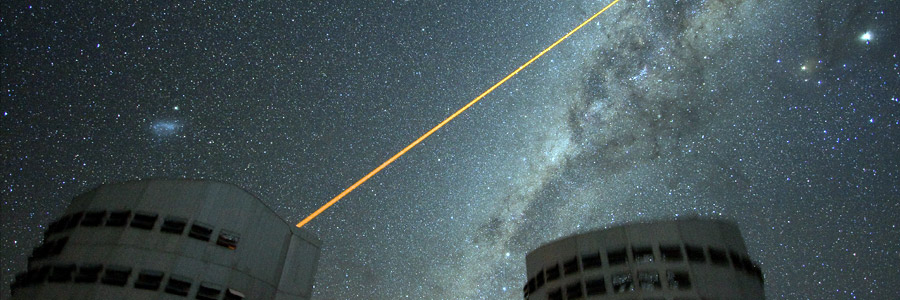
Horizon: Seeing Stars

SEEING STARS
BBC2
Broadcast: August 15th, 2011
Running time: 60 minutes
Director: Ben Lawrie
Cast: Sara Mendes da Costa, Gunther Witzel, Prof. Terry Herter, Dr. Lewis Ball
BBC Horizon: Seeing Stars
European Southern Observatory

In London, where I live, it’s sometimes hard to see the stars, but when it’s a particularly clear night you can look up and see the sky lit up with them, stretching as far as the eyes can see. In awe of them, I always wonder “What’s really out there?”
~ Sara Mendes da Costa (Narrator)
Seeing Stars is an episode in the BBC’s long running Horizon series which gives scientists and philosophers a platform to communicate their changing views of the universe to us. This one focuses on a new breed of super telescopes that are being developed with unprecedented power and clarity.
The Chilean Atacama Desert, where the mountains reach up over one and a half miles into the dry cloudless sky, is where we find one team of astronomers. In their home away from home they’re searching the skies for a black hole, the dense remains of a dead star, with the most advanced optical instrument ever created. The VLT (Very Large Telescope) is made up of four main telescopes each containing identical glass ceramic mirrors, but even with this sophisticated technology, spotting a black hole is no easy feat.

To search for it, they’re using infrared light which is why they’re in the Atacama Desert. Atmospheric moisture filters out infrared light so Atacama’s dry landscape and clear conditions make it the perfect place to set up the VLT with its 23 tonne mirrors that can observe objects four billion times fainter than can be seen with the naked eye.
Other challenges they face while searching for a black hole in the night sky are the tens of thousands of twinkling stars. Stars only twinkle to us because their light is filtered through our atmosphere so they’ve come up with a solution to get past this effect and look into space without it posing such a problem.
As they look deep into the heart of the Milky Way they spot a cluster of high velocity orbiting stars emitting a vast quantity of gasses. They behave in a way which indicates they might be in the vicinity of a super massive black hole, thought to be four million times heavier than our Sun.
With questions leading to more questions, the work of these astronomers never reaches completion. The universe they inhabit is one of constant wonder and inspection.
Seeing Stars gives us just a glimpse of this but emphasises how important ever-evolving technology is for them. How much it’s changed since the time of Galileo Galilei,  who in 1609 constructed his own telescope after hearing about the invention. How far we’ve come from the days we thought the idea of the Earth orbiting the Sun was heresy.
who in 1609 constructed his own telescope after hearing about the invention. How far we’ve come from the days we thought the idea of the Earth orbiting the Sun was heresy.
Although Horizon has been criticised in the past for dumbing down science in favour of focusing more on human stories, Seeing Stars manages to balance both worlds in a way I found engaging and insightful. We see the challenges faced in the world of astronomy and how they’re trying to meet them and answer the big questions about how it all works.
In doing so we might even answer some questions about ourselves; when did we get here and are we alone?

Patrick Samuel
The founder of Static Mass Emporium and one of its Editors in Chief is an emerging artist with a philosophy degree, working primarily with pastels and graphite pencils, but he also enjoys experimenting with water colours, acrylics, glass and oil paints.
Being on the autistic spectrum with Asperger’s Syndrome, he is stimulated by bold, contrasting colours, intricate details, multiple textures, and varying shades of light and dark. Patrick's work extends to sound and video, and when not drawing or painting, he can be found working on projects he shares online with his followers.
Patrick returned to drawing and painting after a prolonged break in December 2016 as part of his daily art therapy, and is now making the transition to being a full-time artist. As a spokesperson for autism awareness, he also gives talks and presentations on the benefits of creative therapy.
Static Mass is where he lives his passion for film and writing about it. A fan of film classics, documentaries and science fiction, Patrick prefers films with an impeccable way of storytelling that reflect on the human condition.
© 2022 STATIC MASS EMPORIUM . All Rights Reserved. Powered by METATEMPUS | creative.timeless.personal. | DISCLAIMER, TERMS & CONDITIONS
HOME | ABOUT | CONTACT | TWITTER | GOOGLE+ | FACEBOOK | TUMBLR | YOUTUBE | RSS FEED
CINEMA REVIEWS | BLU-RAY & DVD | THE EMPORIUM | DOCUMENTARIES | WORLD CINEMA | CULT MOVIES | INDIAN CINEMA | EARLY CINEMA
MOVIE CLASSICS | DECONSTRUCTING CINEMA | SOUNDTRACKS | INTERVIEWS | THE DIRECTOR’S CHAIR | JAPANESE CINEMA





